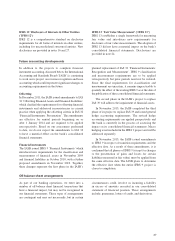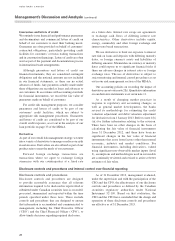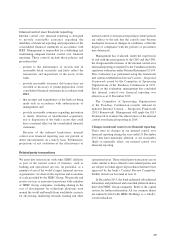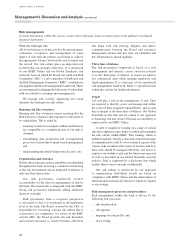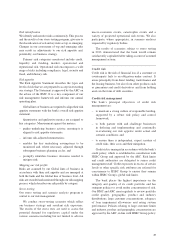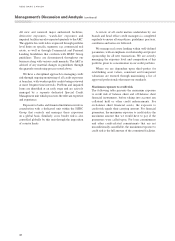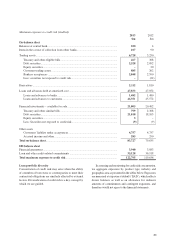HSBC 2013 Annual Report Download - page 39
Download and view the complete annual report
Please find page 39 of the 2013 HSBC annual report below. You can navigate through the pages in the report by either clicking on the pages listed below, or by using the keyword search tool below to find specific information within the annual report.
37
The overall credit quality at 31 December 2013 improved
compared with 2012 as a result of a 3.3% movement
from satisfactory to good and strong categorized loans
and advances. The improvement was primarily driven
by the wholesale portfolio as the result of refocussing
the business on existing high quality relationships and a
more selective risk appetite. In addition contributing to
the improvement was our retail portfolio primarily as a
result of the run-off consumer finance portfolio and the
sale of the private label credit card portfolio in the third
quarter of 2013.
Renegotiated loans
The carrying amount of loans that would otherwise be
past due or impaired whose terms have been renegotiated
was $237m at 31 December 2013 (2012: $266m).
Loans past due but not impaired
Examples of exposures considered past due but not
impaired include loans that have missed the most
recent payment date but on which there is no evidence
of impairment; loans fully secured by cash collateral;
residential mortgages in arrears more than 90 days, but
where the value of collateral is sufficient to repay both
the principal debt and all potential interest for at least
one year; and short-term trade facilities past due more
than 90 days for technical reasons such as delays in
documentation, but where there is no concern over the
creditworthiness of the counterparty.
The aging analysis below includes past due loans
on which collective impairment allowances have been
assessed, though at their early stage of arrears, there is
normally no identifiable impairment.
Days past due but not impaired loans and advances (Audited)
2013
$m
2012
$m
Up to 29 days ................................................................................................................. 546 626
30–59 days ..................................................................................................................... 93 146
60–89 days ..................................................................................................................... 28 72
90–179 days ................................................................................................................... –35
Over 180 days ................................................................................................................ 810
675 889
Impaired loans and allowance for credit losses
When impairment losses occur, we reduce the carrying
amount of loans through the use of an allowance account
with a charge to income. The allowance for credit losses
consists of both individually assessed and collectively
assessed allowances, each of which is reviewed on a
regular basis. The allowance for credit losses reduces
the gross value of an asset to its net carrying value.
An allowance is maintained for credit losses which,
in management’s opinion, is considered adequate to
absorb all incurred credit-related losses in our portfolio,
of both on and off-balance sheet items, including
deposits with other regulated financial institutions,
loans, acceptances, derivative instruments and other
credit-related contingent liabilities, such as letters of
credit and guarantees.
Assessing the adequacy of the allowance for credit
losses is inherently subjective as it requires making
estimates that may be susceptible to significant change.
This includes the amount and timing of expected future
cash flows and incurred losses for loans that are not
individually identified as being impaired.
Individually significant accounts are treated as
impaired as soon as there is objective evidence that an
impairment loss has been incurred. The criteria used by us
to determine that there is such objective evidence include:
– known cash flow difficulties experienced by the
borrower;
– past-due contractual payments of either principal or
interest;
– breach of loan covenants or conditions;
– the probability that the borrower will enter
bankruptcy or other financial realization; and
– a significant downgrading in credit rating by an
external credit rating agency.
Individually assessed impairment allowances are
recorded on these individual accounts on an account-by-
account basis to reduce their carrying value to estimated
realizable amount.
The collectively assessed impairment allowance
is our best estimate of incurred losses in the portfolio
for those individually significant accounts for which
37


